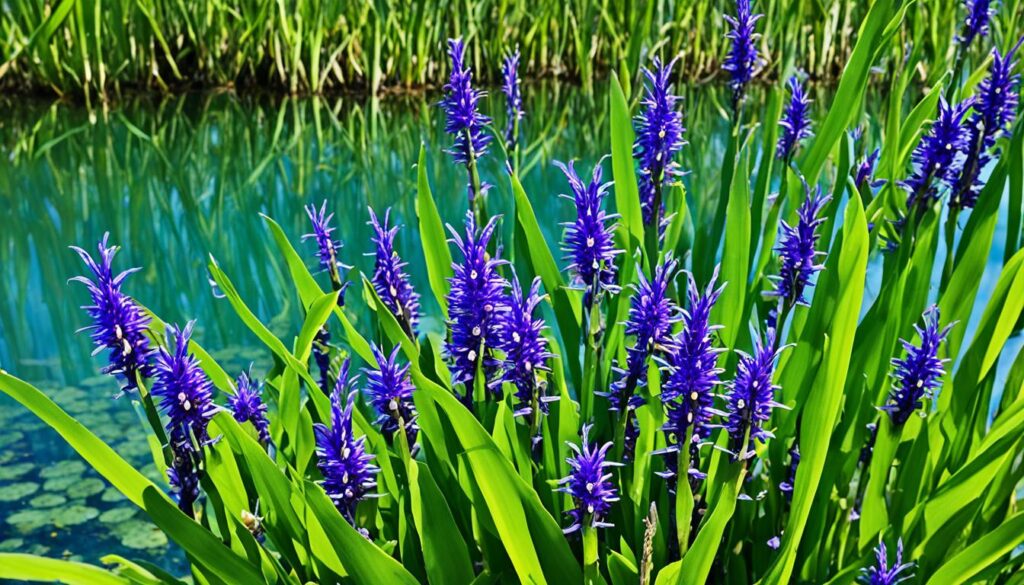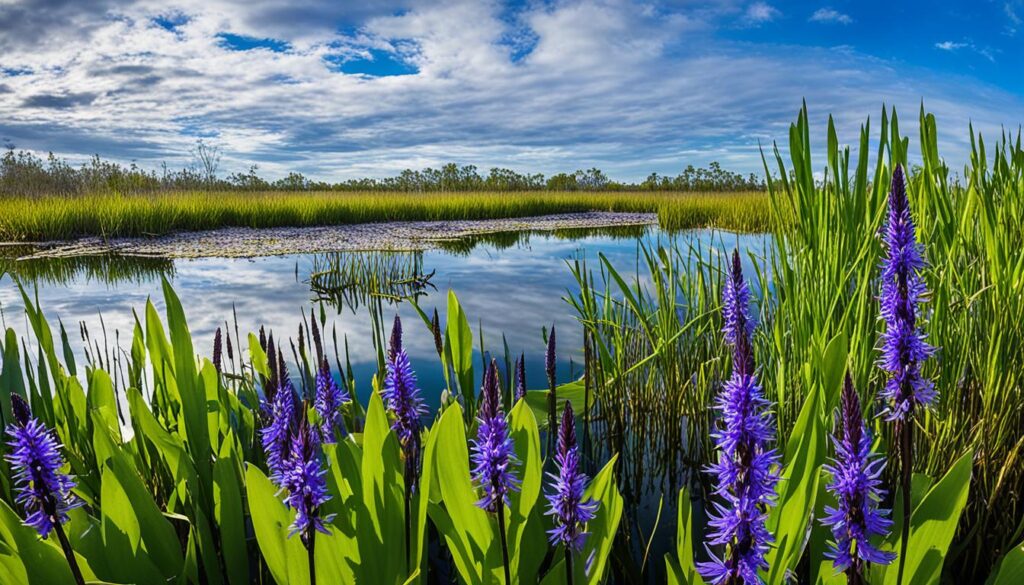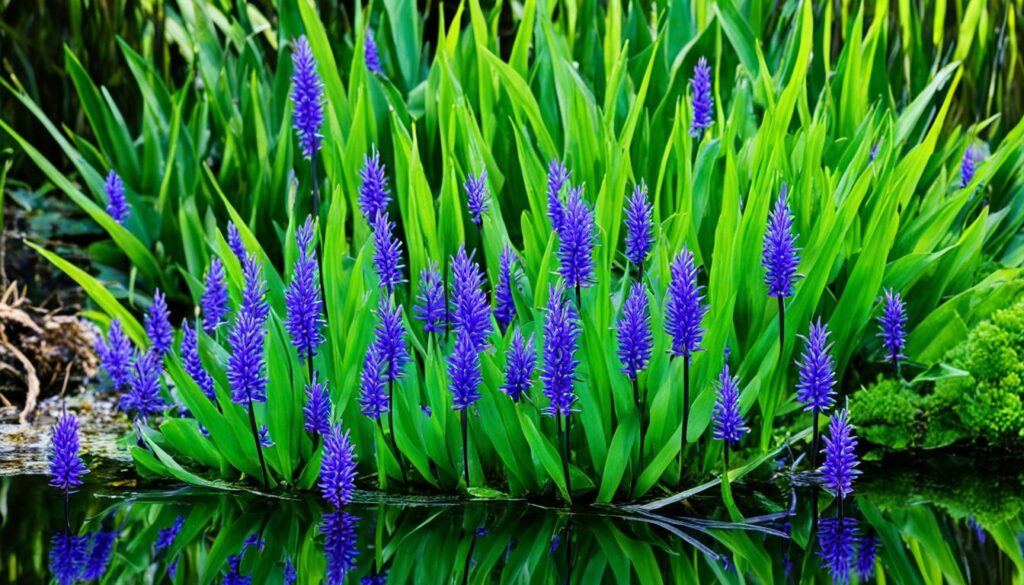In this comprehensive guide, I will provide all the information you need about the Pickerelweed Florida Aquatic Plant. From its benefits and care guide to its habitat and growth conditions, you’ll understand how this beautiful plant can enhance wetland habitats and water gardens.
Angler’s Essentials:
- Pickerelweed is a native aquatic plant in Florida that thrives in wetland habitats and water gardens.
- Proper care, including watering requirements and sunlight exposure, is crucial for the health of Pickerelweed.
- Pickerelweed offers various benefits, such as supporting wildlife and improving ecosystem water quality.
- Landscaping with Pickerelweed can add aesthetic appeal to wetland habitats and water gardens.
- By following the care guide and understanding its benefits, you can create a thriving ecosystem and enjoy the beauty of Pickerelweed.
Understanding Pickerelweed: Habitat and Growth Conditions
Before delving into the care and benefits of the Pickerelweed Florida Aquatic Plant, it’s crucial to grasp its native habitat and the optimal conditions for its growth. Understanding its natural environment can provide the best care for this remarkable plant.
The Pickerelweed, scientifically known as Pontederia cordata, is native to Florida and thrives in wetland habitats throughout the state. Found in marshes, swamps, and along the edges of lakes and ponds, Pickerelweed plays a vital role in maintaining the balance of these aquatic ecosystems.
Pickerelweed is a versatile plant that can adapt to various conditions, making it suitable for natural wetland restoration projects and home water gardens. It prefers full or partial sunlight, although it can tolerate some shade. The ideal water depth for Pickerelweed ranges between 6 and 18 inches, balancing water availability and root oxygenation.
Factors such as water quality, soil type, and temperature influence pickerelweed’s growth conditions. The plant performs best in slightly acidicevels, ranging from 5.5 to 7.5. It thrives in moist to wet soils, preferring to neutral pH l loamy or sandy substrates. Additionally, Pickerelweed can tolerate fluctuating water levels, making it resilient to seasonal changes.
| Growth Conditions | Ideal Range |
|---|---|
| Light Exposure | Full sun to partial shade |
| Water Depth | 6 to 18 inches |
| Water Quality | Slightly acidic to neutral (pH 5.5 to 7.5) |
| Soil Type | Moist to wet, loamy or sandy |
| Temperature | Adapts to various climates |
Pickerelweed is a hardy perennial that can withstand temperatures down to -10°F (-23°C), allowing it to thrive in different regions across the United States. Its ability to tolerate drought and flooding makes it a resilient and adaptable aquatic plant.
By recreating the natural growth conditions of Pickerelweed in our gardens and restoration projects, we can witness its beauty and contribute to the preservation of wetland habitats. The following sections will delve deeper into the care guide and the numerous benefits of Pickerelweed for both wildlife support and landscaping ideas.
Care Guide for Pickerelweed
To ensure the health and vitality of your Pickerelweed, it’s crucial to provide proper care. In this section, I will provide a detailed care guide, including information on watering requirements, sunlight exposure, and maintenance tips to keep your Pickerelweed in optimal condition.
Watering Requirements
Pickerelweed is a Florida aquatic plant that thrives in wetland habitats and water gardens. As such, it requires consistent moisture to flourish. Watering the plant regularly is recommended to keep the soil moist but not waterlogged. Check the soil’s moisture levels by inserting your finger about an inch deep. If it feels dry, it’s time to water your Pickerelweed.
Pro tip: During hot summer months or periods of drought, it may be necessary to increase the watering frequency to prevent the soil from drying out completely.
Sunlight Exposure
Pickerelweed grows best in full sun to partial shade, receiving at least 4-6 hours of direct sunlight daily. However, it can also tolerate shade, making it versatile for different garden settings. When planting Pickerelweed, choose a location that provides the ideal balance of sunlight exposure for the plant’s optimal growth.
Pro tip: If you’re planting Pickerelweed in a water garden, ensure it receives adequate sunlight by avoiding densely shaded areas or excessive overhead vegetation.
Maintenance Tips
Maintaining your Pickerelweed is relatively simple, but a few key practices will ensure its long-term health:
- Regularly remove any dead or decaying foliage to promote new growth and prevent the accumulation of debris.
- Monitor the presence of pests, such as aphids or snails, and promptly address any infestation to prevent damage to the plant.
- Divide overcrowded clumps of Pickerelweed every 2-3 years to promote healthier growth and maintain its aesthetic appeal.
Pro tip: Consider adding a layer of mulch around your Pickerelweed to help retain moisture and suppress weed growth. This will also enhance the overall appearance of your garden by providing a neat and well-maintained look.

As you implement these care tips, your Pickerelweed will thrive and contribute to the beauty and ecological balance of your wetlands or water garden. Remember to monitor its watering, sunlight, and maintenance to ensure a healthy and vibrant plant.
Benefits of Pickerelweed for Wetland Habitats and Water Gardens
Pickerelweed, a native Florida aquatic plant, offers numerous benefits when integrated into wetland habitats and water gardens. Its unique characteristics make it a valuable addition to any aquatic ecosystem, supporting wildlife, improving water quality, and offering exciting landscaping ideas.
1. Wildlife Support
Pickerelweed plays a crucial role in supporting various forms of wildlife. Its dense foliage provides shelter and nesting areas for birds, reptiles, and amphibians. The plant’s upright stems also offer perching spots for dragonflies and other beneficial insects, which act as natural pest control by preying on mosquitoes and other unwanted pests.
Furthermore, Pickerelweed’s vibrant purple-blue flowers attract pollinators such as bees and butterflies, contributing to the overall biodiversity of the habitat. Incorporating Pickerelweed into wetland areas and water gardens creates a thriving environment that supports a wide range of wildlife species.
2. Water Quality Improvement
Pickerelweed is vital in improving water quality in wetland habitats and water gardens. Its extensive root system helps stabilize soil and prevent erosion, reducing the sediment and nutrient runoff into the water. This, in turn, minimizes the risk of algal blooms and promotes clearer, healthier water.
The roots of Pickerelweed also act as natural filters, absorbing excess nutrients, such as nitrogen and phosphorus, from the water. This process helps maintain a balanced and nutrient-rich environment, benefiting aquatic plants and wildlife.
3. Landscaping Ideas
With its tall, vibrant stems and striking flowers, Pickerelweed adds aesthetic appeal to wetland habitats and water gardens. Its architectural form creates visual interest and can be used as a focal point or background element in landscape designs. The plant’s upright growth habit and vibrant color make it a standout feature in formal and informal garden settings.
Pairing Pickerelweed with other water-loving plants, such as water lilies or cattails, creates visually pleasing plant combinations and enhances the overall beauty of the landscape. Whether you’re looking to make a serene water garden or a natural wetland habitat, Pickerelweed offers versatile landscaping opportunities.
4. Maintenance and Care
When incorporating Pickerelweed into wetland habitats or water gardens, it’s essential to provide proper care. Ensure that the plant receives adequate sunlight and is planted in well-drained soil or submerged in water at varying depths, depending on the specific species of Pickerelweed.
While Pickerelweed is relatively low-maintenance, regular monitoring is necessary to ensure it doesn’t overcrowd other aquatic plants. Regularly remove any dead or decaying plant material to prevent the buildup of organic matter, which can negatively impact water quality.

| Benefits of Pickerelweed | Summary |
|---|---|
| Wildlife Support | Provides shelter and nesting areas for birds, reptiles, and amphibians. Attracts beneficial insects. |
| Water Quality Improvement | Stabilizes soil, reduces sediment and nutrient runoff, absorbs excess nutrients. |
| Landscaping Ideas | Adds aesthetic appeal, used as a focal point or background element, enhances landscape designs. |
| Maintenance and Care | Requires adequate sunlight and appropriate planting conditions, regular monitoring. |
Conclusion
In conclusion, the Pickerelweed Florida Aquatic Plant is a valuable addition to wetland habitats and water gardens. Its ability to thrive in specific growth conditions and provide numerous benefits makes it an essential plant for creating a thriving ecosystem.
By following the care guide outlined in this article, you can ensure that your Pickerelweed receives the proper care it needs to flourish. Understanding its water requirements, sunlight exposure, and maintenance tips will contribute to its overall health and vitality.
Pickerelweed enhances the aesthetic appeal of wetland habitats and water gardens, supports wildlife, and improves water quality. Its presence contributes to a balanced ecosystem and provides a habitat for various species.
Embrace the beauty of Pickerelweed and positively impact your environment by incorporating it into your wetland habitats and water gardens. With proper care and understanding of its benefits, you can create an ecosystem that thrives and enjoys this remarkable plant’s many advantages.
FAQ
What is Pickerelweed?
Pickerelweed is an aquatic plant native to Florida, known for its vibrant purple-blue flowers and lance-shaped leaves. It is a popular choice for wetland habitats and water gardens due to its aesthetic appeal and the numerous benefits it provides to the ecosystem.
How can Pickerelweed be beneficial?
Pickerelweed offers several benefits to wetland habitats and water gardens. It helps improve water quality by absorbing excess nutrients and filtering pollutants. Additionally, it provides shelter and food for various wildlife species, contributing to the overall biodiversity of the ecosystem.
What are the care requirements for Pickerelweed?
Pickerelweed thrives in moist to wet soil and prefers partial to full sun exposure. It requires regular watering to keep the soil consistently moist, especially during periods of drought. Avoid overwatering, as it can lead to root rot. Regular maintenance, such as removing dead leaves and flowers, is also necessary to keep the plant healthy.
Where does Pickerelweed naturally grow?
Pickerelweed is native to the wetland habitats of Florida and can be found growing in marshes, swamps, and along the edges of freshwater lakes, ponds, and streams. It is well-adapted to the subtropical climate of Florida and can withstand both flooding and drought conditions.
Can Pickerelweed be used in landscaping?
Yes, Pickerelweed can be used to enhance the aesthetics of water gardens and wetland landscapes. Its striking purple-blue flowers and tall, erect growth make it a visually appealing choice for landscaping projects. It can be planted alongside other aquatic plants and incorporated into naturalistic designs or formal garden settings.
